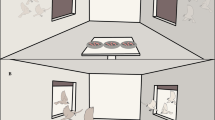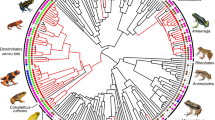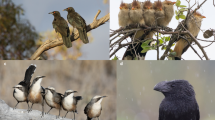Abstract
Highly structured social systems can involve close kinship groups (eusocial insects1, lion prides2, helpers-at-the-nest in birds3). However, kinship generally has not been considered to be important or necessary for what seem to be merely gregarious phenomena, such as schooling behaviour4. In fact, Fisher first proposed kinship theory to explain the evolution of noxious taste in certain gregarious insect larvae. He reasoned that traits which at first may not be directly beneficial to the individual, such as distastefulness or warning coloration, might be selected for if they conferred advantage to siblings in the swarm5. Like some insect larvae, the tadpoles of many toads (genus Bufo) are conspicuously coloured, distasteful to predators and highly gregarious, forming densely packed schools in open areas along pond shores6. The tadpoles' aggregative behaviour may be important for feeding efficiency7,8, thermoregulation9 or predator deterrence8, but their conspicuousness coupled with their distastefulness suggest that schooling may also serve an apose-matic function. Consistent with the predictions of a kin selection model, we report here that tadpoles of the American toad (Bufo americanus) preferentially associate with siblings in laboratory conditions.
This is a preview of subscription content, access via your institution
Access options
Subscribe to this journal
Receive 51 print issues and online access
$199.00 per year
only $3.90 per issue
Buy this article
- Purchase on Springer Link
- Instant access to full article PDF
Prices may be subject to local taxes which are calculated during checkout
Similar content being viewed by others
References
Wilson, E. O. Insect Societies (Belknap Press of Harvard University Press, 1971).
Bertram, B. C. R. in Growing Points in Ethology (eds Bateson, P. P. G. & Hinde, R. A.) 281–301 (Cambridge University Press, 1976).
Brown, J. L. A. Rev. ecol. Systems 9, 123–155 (1978).
Shaw, E. Am. Scient. 66 166–175 (1978).
Fisher, R. A. The Genetical Theory of Natural Selection (Clarendon, Oxford, 1930).
Wassersug, R. J. in Evolutionary Biology of the Anurans (ed. Vial, J. L.) 273–297 (University of Missouri Press, 1973).
Richmond, N. D. Ecology 28 53–67 (1947).
Bragg, A. N. Gnomes of the Night: the Spadefoot Toads (University of Pennsylvania Press, 1965).
Brattstrom, B. H. Herpetologica 18, 38–46 (1962).
Gosner, K. L. Herpetologica 16, 183–190 (1960).
Bekoff, M. in Parental Behavior in Mammals (eds Gubernick, D. & Klopfer, P. H.) (Plenum, New York, in the press).
Porter, R. H., Wyrick, M. & Pankey, J. Behav. Ecol. Sociobiol 3, 61–68 (1978).
Williams, G. C. Michigan St. Univ. Mus. Pubis Biol. Ser. 2, 349–384 (1964).
Hamilton, W. D. J. theor. Biol. 31, 295–311 (1971).
Hamilton, W. D. J. theor. Biol. 7, 1–52 (1964).
Kulzer, E. Z. vergl. Physiol 36, 443–463 (1954).
Pfeiffer, W. in Pheromones (ed. Birch, M. C.) 269–296 (North-Holland, Amsterdam, 1974).
Matthews, E. G. Am. Nat. 111, 213–222 (1977).
Sokal, R. R. & Rohlf, F. J. Biometry (Freeman, San Francisco, 1969).
Author information
Authors and Affiliations
Rights and permissions
About this article
Cite this article
Waldman, B., Adler, K. Toad tadpoles associate preferentially with siblings. Nature 282, 611–613 (1979). https://doi.org/10.1038/282611a0
Received:
Accepted:
Issue Date:
DOI: https://doi.org/10.1038/282611a0
This article is cited by
-
Grouping rule in tadpole: is quantity more or size assortment more important?
Animal Cognition (2023)
-
Perception of con- and heterospecific injury cues in tadpoles of dendrobatid, ranid and bufonid frogs (Anura)
Evolutionary Ecology (2023)
-
The molecular basis and evolution of toxin resistance in poison frogs
Evolutionary Ecology (2023)
-
Increasingly cautious sampling, not the black colouration of unpalatable prey, is used by fish in avoidance learning
Animal Cognition (2023)
-
Plasticity for the kin and conspecific preferences in the frog tadpoles (Rana ornativentris)
Animal Cognition (2022)
Comments
By submitting a comment you agree to abide by our Terms and Community Guidelines. If you find something abusive or that does not comply with our terms or guidelines please flag it as inappropriate.



